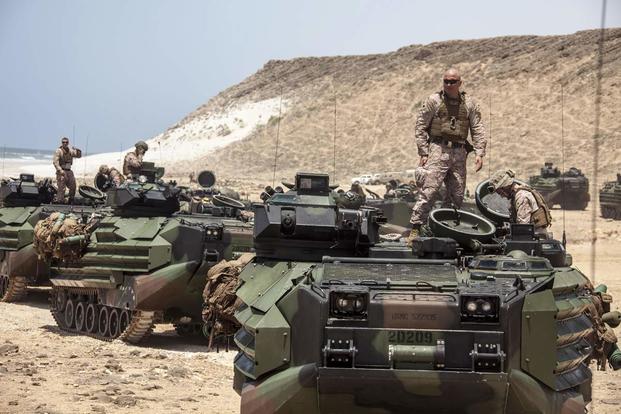The Marines will have to wait another decade to increase the speed of its amphibious troop carriers, Marine Corps officials said Tuesday.
The service is pushing forward with plans to build about 200 new Amphibious Combat Vehicles that will ultimately replace the older, Amphibious Assault Vehicle fleet.
High-water speed has been a key requirement since these armored troop carriers are designed for forced-entry operations. Marine officials, however, have decided to postpone a decision on the requirement until 2025, Marine officials said at the 2015 Sea, Air and Space conference hosted at National Harbor, Md.
"High-water speed is still an important requirement for us. We are just going to have to figure out how to go about doing that," said Marine Maj. Gen. Andrew O'Donnell, assistant deputy commandant for Combat Development & Integration.
The ACV is the service's top modernization priority, but it will not immediately replace the AAV. The Corps will upgrade 392 AAVs to compliment the new ACVs.
The Marines are considering using Landing Craft Air Cushion ships to carry two ACVs at speeds up to 40 knots until they get within 12 miles of shore, Marine officials said. Leaders also talked of using Heavy Lift Barge Carriers to service as "mother ships" for LCACs during such operations.
This was part of a larger discussion on the Navy and Marine Corps vision of sea-basing – a concept that the services have been developing to create floating staging bases for amphibious warfare operations.
Related Video
"Expeditionary Force 21 and sea-basing is no longer a power-point slide," Rear Adm. T.K. Shannon, commander of Military Sealift Command said during the discussion.
The Pentagon has a requirement for 38 amphibious ships, but tight defense budgets have forced the service to scale it back to 33.
Leaders from both sea services maintain that the actual requirement is closer to 50 amphibious ships.
"As we rebalance to the Pacific … we are seeing a constant demand for amphibious warships," said Marine Corps Maj. Gen. Robert Walsh, director of Expeditionary Warfare.
To meet the growing demand, both the Navy and the Marines are turning to older ships, often revamping them for completely new missions.
The Navy saw great success doing this with the USS Ponce, a steam-powered amphibious docking ship on its way to retirement. The service retrofitted it to become the first floating staging base while leaders finalized requirements and completed the first purpose-built Afloat Forward Staging Base, which is now the USNS William B. Puller.
"There are a lot of missions this ship is capable of performing," Shannon said. "Prior to 2012, our Navy did not have an Afloat Forward Staging Base."
-- Matthew Cox can be reached at matthew.cox@military.com






























